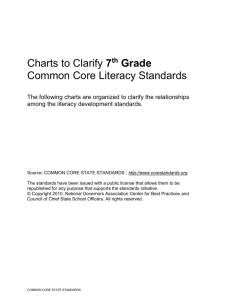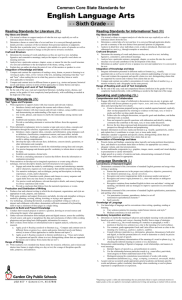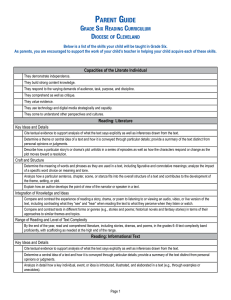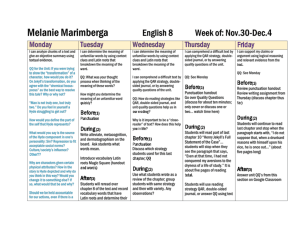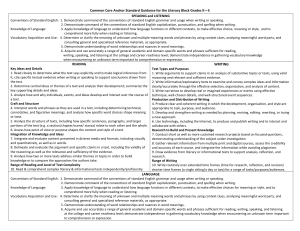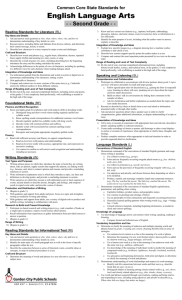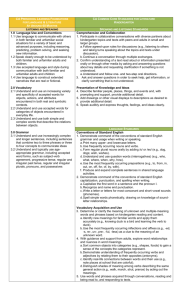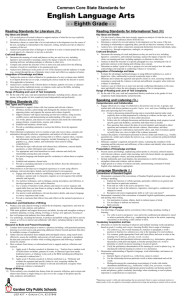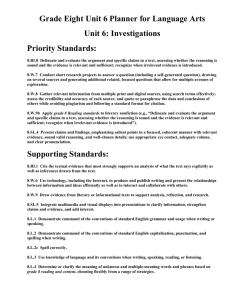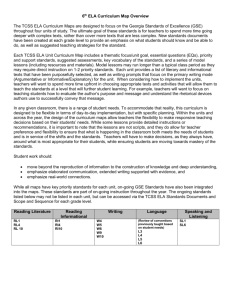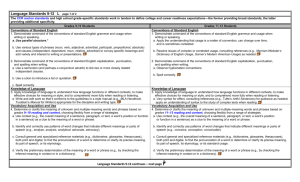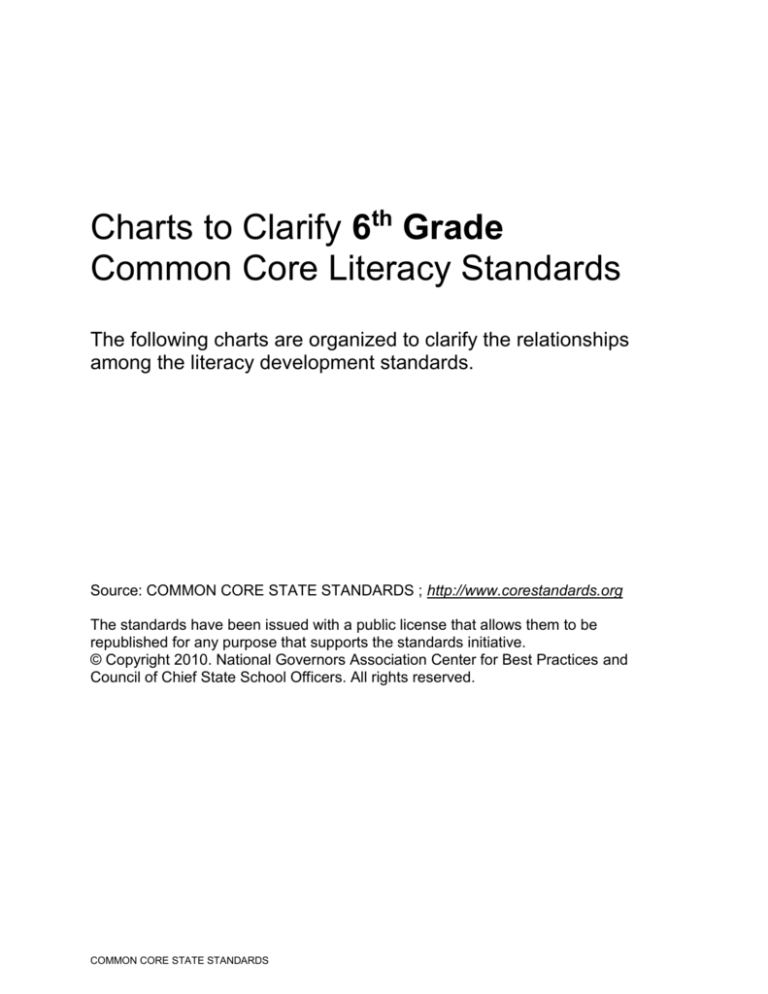
Charts to Clarify 6th Grade
Common Core Literacy Standards
The following charts are organized to clarify the relationships
among the literacy development standards.
Source: COMMON CORE STATE STANDARDS ; http://www.corestandards.org
The standards have been issued with a public license that allows them to be
republished for any purpose that supports the standards initiative.
© Copyright 2010. National Governors Association Center for Best Practices and
Council of Chief State School Officers. All rights reserved.
COMMON CORE STATE STANDARDS
Core Reading Standards for Sixth Grade
LITERATURE
KEY IDEAS AND DETAILS
1. Cite textual evidence to support analysis of
what the text says explicitly as well as
inferences drawn from the text.
2. Determine a theme or central idea of a text
and how it is conveyed through particular
details; provide a summary of the text distinct
from personal opinions or judgments.
3. Describe how a particular story’s or drama’s
plot unfolds in a series of episodes as well as
how the characters respond or change as the
plot moves toward a resolution.
CRAFT AND STRUCTURE
4. Determine the meaning of words and
phrases as they are used in a text, including
figurative and connotative meanings;
analyze the impact of a specific word choice
on meaning and tone.
5. Analyze how a particular sentence, chapter,
scene, or stanza fits into the overall structure
of a text and contributes to the development of
the theme, setting, or plot.
6. Explain how an author develops the point of
view of the narrator or speaker in a text.
INTEGRATION OF KNOWLEDGE AND IDEAS
7. Compare and contrast the experience of
reading a story, drama, or poem to listening to
or viewing an audio, video, or live version of
the text, including contrasting what they “see”
and “hear” when reading the text to what they
perceive when they listen or watch.
8. (Not applicable to literature)
9. Compare and contrast texts in different forms
or genres (e.g., stories and poems; historical
novels and fantasy stories) in terms of their
approaches to similar themes and topics.
RANGE AND LEVEL OF TEXT COMPLEXITY
10. By the end of the year, read and
comprehend literature, including stories,
dramas, and poems, in the grades 6–8 text
complexity band proficiently, with scaffolding
as needed at the high end of the range.
COMMON CORE STATE STANDARDS
NONFICTION/INFORMATIONAL TEXT
KEY IDEAS AND DETAILS
1. Cite textual evidence to support analysis of
what the text says explicitly as well as
inferences drawn from the text.
2. Determine a central idea of a text and how it is
conveyed through particular details; provide a
summary of the text distinct from personal
opinions or judgments.
3. Analyze in detail how a key individual, event, or
idea is introduced, illustrated, and elaborated in
a text (e.g., through examples or anecdotes).
CRAFT AND STRUCTURE
4. Determine the meaning of words and phrases
as they are used in a text, including figurative,
connotative, and technical meanings.
5. Analyze how a particular sentence, paragraph,
chapter, or section fits into the overall structure
of a text and contributes to the development of
the ideas.
6. Determine an author’s point of view or
purpose in a text and explain how it is
conveyed in the text.
INTEGRATION OF KNOWLEDGE AND IDEAS
7. Integrate information presented in different
media or formats (e.g., visually, quantitatively)
as well as in words to develop a coherent
understanding of a topic or issue.
8. Trace and evaluate the argument and specific
claims in a text, distinguishing claims that are
supported by reasons and evidence from
claims that are not.
9. Compare and contrast one author’s
presentation of events with that of another
(e.g., a memoir written by and a biography on
the same person).
RANGE AND LEVEL OF TEXT COMPLEXITY
10. By the end of the year, read and comprehend
literary nonfiction in the grades 6-8 text
complexity band proficiently, with scaffolding
as needed at the high end of the range.
2
The Speaking and Listening Standards are Keys to Learning ACROSS
the Curriculum
Comprehension and Collaboration
SL.6.1 Engage effectively in a range of collaborative discussions (one-on-one, in
groups, and teacher-led) with diverse partners on grade 6 topics, texts, and issues,
building on others’ ideas and expressing their own clearly.
__SL.6.1a Come to discussions prepared, having read or studied required material;
explicitly draw on that preparation by referring to evidence on the topic, text, or
issue to probe and reflect on ideas under discussion.
__SL.6.1b Follow rules for collegial discussions, set specific goals and deadlines,
and define individual roles as needed.
__SL.6.1c Pose and respond to specific questions with elaboration and detail by
making comments that contribute to the topic, text, or issue under discussion.
__SL.6.1d Review the key ideas expressed and demonstrate understanding of
multiple perspectives through reflection and paraphrasing.
SL.6.2 Interpret information presented in diverse media and formats (e.g., visually,
quantitatively, orally) and explain how it contributes to a topic, text, or issue under
study.
SL.6.3 Delineate a speaker’s argument and specific claims, distinguishing claims
that are supported by reasons and evidence from claims that are not.
Presentation of Knowledge and Ideas
SL.6.4 Present claims and findings, sequencing ideas logically and using pertinent
descriptions, facts, and details to accentuate main ideas or themes; use appropriate
eye contact, adequate volume, and clear pronunciation.
SL.6.5 Include multimedia components (e.g., graphics, images, music, sound) and
visual displays in presentations to clarify information.
SL.6.6 Adapt speech to a variety of contexts and tasks, demonstrating command of
formal English when indicated or appropriate.
Students exercise Speaking and Listening competencies as they proceed through
the gradual release of responsibility.
Integrate the Conventions in Writing and Speaking (see the next page).
COMMON CORE STATE STANDARDS
3
Language
Sixth Grade
CONVENTIONS IN WRITING AND SPEAKING
1. Observe conventions of grammar and usage.
__a. Ensure that pronouns are in the proper case (subjective, objective,
possessive).
__b. Recognize and correct inappropriate shifts in pronoun number and person.*
__c. Recognize and correct vague pronouns (i.e., ones with unclear or
ambiguous antecedents).*
2. Observe conventions of capitalization, punctuation, and spelling.
__a. Use commas, parentheses, or dashes to set off nonrestrictive/parenthetical
elements.*
__b. Spell correctly.
3. Make effective language choices.
__a. Vary sentence patterns for meaning, reader/listener interest, and style.*
VOCABULARY ACQUISITION AND USE
4. Determine word meanings (based on grade 6 reading).
__a. Determine or clarify the meaning of unknown or multiple-meaning words
through the use of one or more strategies, such as using semantic clues (e.g.,
sentence and paragraph context, the organizational pattern of the text); using
syntactic clues (e.g., the word’s position or function in the sentence); analyzing
the word’s sounds, spelling, and meaningful parts; and consulting reference
materials, both print and digital.
__b. Use a known root as a clue to the meaning of an unknown word (e.g.,
audience, auditory, audible).
__c. Verify the preliminary determination of a word’s meaning (e.g., by checking
the inferred meaning in context or looking up the word in a dictionary).
__d. Interpret various figures of speech (e.g., personification) relevant to
particular texts.
5. Understand word relationships.
__a. Trace the network of uses and meanings that different words have and the
interrelationships among those meanings and uses.
__b. Distinguish a word from other words with similar denotations but different
connotations.
6. Use grade-appropriate general academic vocabulary and English language
arts–specific words and phrases taught directly and gained through reading and
responding to texts.
* Conventions standards noted with an asterisk need to be revisited by
students in subsequent grades.
COMMON CORE STATE STANDARDS
4
WRITING
Sixth Grade
TEXT TYPES AND PURPOSES
1. Write arguments in which they:
__a. Introduce a claim about a topic or issue and organize the reasons and evidence to support
the claim.
__b. Support the claim with clear reasons and relevant evidence.
__c. Use words, phrases, and clauses to convey the relationships among claims and reasons.
__d. Sustain an objective style and tone.
__e. Provide a concluding statement or section that follows from the argument.
2. Write informative/explanatory texts in which they:
__a. Introduce a topic and organize information appropriate to the purpose, using strategies such
as definition, classification, comparison/contrast, and cause/effect.
__b. Develop the topic with relevant facts, definitions, concrete details, quotations, or other
information and examples.
__c. Use appropriate links and varied sentence structures to join and clarify ideas.
__d. Use straightforward language to create an objective style appropriate for a reader seeking
information.
__e. Provide a conclusion that follows logically from the information or explanation presented.
3. Write narratives in which they:
__a. Engage and orient the reader by establishing a context and point of view, and organize a
sequence of events or experiences.
__b. Develop narrative elements (e.g., setting, event sequence, characters) using relevant sensory
details.
__c. Use a variety of transition words, phrases, and clauses to convey sequence, shift from one
time frame or setting to another, and/or show the relationships among events and experiences.
__d. Choose words and phrases to develop the events, experiences, and ideas precisely.
__e. Provide a satisfying conclusion that follows from the events, experiences, or ideas.
PRODUCTION AND DISTRIBUTION OF WRITING
4. Produce writing in which the organization, development, substance, and style are appropriate
to task, purpose, and audience. (Grade-specific expectations for writing types are defined in
Standards 1–3 above.)
5. With some guidance and support from peers and adults, strengthen writing as needed by
planning, revising, editing, rewriting, or trying a new approach.
6. Use technology, including the Internet, to produce, publish, and interact with others about
writing, including linking to and citing online sources.
RESEARCH TO BUILD KNOWLEDGE
7. Perform short, focused research projects in response to a question and refocus the inquiry in
response to further research and investigation.
8. Gather relevant information from multiple print and digital sources, assess the credibility of
each source, and quote or paraphrase the data and conclusions of others while avoiding
plagiarism and documenting sources.
9. Write in response to literary or informational sources, drawing evidence from the text to support
analysis and reflection as well as to describe what they have learned.
__a. Apply grade 6 reading standards to literature (e.g., “Analyze stories in the same genre (e.g.,
mysteries, adventure stories), comparing and contrasting their approaches to similar themes
and topics.”).
__b. Apply grade 6 reading standards to literary nonfiction (e.g., “Distinguish among fact, opinion,
and reasoned judgment presented in a text”).
RANGE OF WRITING
10. Write routinely over extended time frames (time for research, reflection, and revision) and
shorter time frames (a single sitting or a day or two) for a range of tasks, purposes, and
audiences.
COMMON CORE STATE STANDARDS
5

